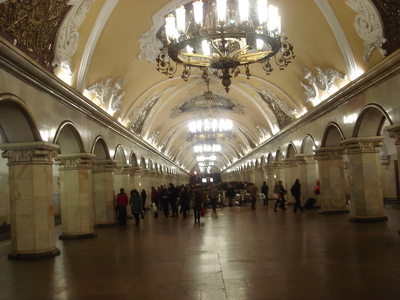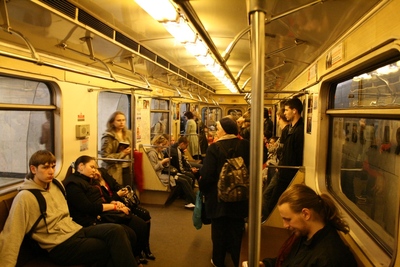
Komsomolskaya Station, a good example of the extravagant architecture in the Moscow Metro system.
Upon arriving in Moscow, I was excited to be able to ride on the Moscow Metro: in guidebooks and in professors' descriptions, it was made out to be a monumental and monumentally useful mass transit system. And I must say, I was not disappointed. It seemed consistently the fastest way to get from point to point while I was there, making our group's bus trips across the city frustrating, to say the least. For less than a US dollar, you could ride across Moscow on quick-running trains that arrived at the station every minute to minute and a half. Granted, the stations were sometimes farther apart than I might have liked, and the trains old and sometimes poorly cleaned, but the overall experience was a positive one.

Further, the stations themselves were absolutely amazing: the architecture was elaborate, with even the simplest stations I was able to find having plaster ceilings, bronze hanging light fixtures, and marble tile floors. The stations were generously proportioned, with more than ample room to wait for trains, clear directional signs, and (generally) more than enough turnstiles to ensure a steady flow of passengers in from the street.
Indeed, the Moscow metro seems to stand as a monument for everything Soviet transit planning was meant to be, and it received the most adequate funding of any transport project in the Soviet Union as a result. (White 1) However, the focus on the Moscow Metro (and other subways) has been more than symbolic: the metro is the one form of urban transit able to escape the traffic of the streets, and, given the Soviet priority on decreasing transit times, it has been a logical choice for increased development, in Moscow and elsewhere. (White 15–18) Accordingly, the Moscow Metro is an extensive system, spanning some 221 route-kilometers with 138 stations (as of 1991) (Bakulin 139), and carrying some 9 million passengers each day (as of 2003). (O'Grady)
This perception of the metro as superior to other forms of transit, however, seems to have been long-running in Soviet urban planning circles: at the World's Fair in 1939, in response to the American “World of Tomorrow” exhibit, the Soviet government planned an elaborate exhibit including scale models of reconstruction plans for Moscow. Central to this exhibit was a full-scale recreation of a section of the Mayakovskaya metro section, then under construction: this was seen as a demonstration of the superiority of Soviet plans for urban reconstruction after the Second World War, with their focus on large-scale projects aiming to increase the quality of life for urban denizens. (Swift 371)
But, of course, part of the appeal of this exhibit was due to the inherently-symbolic architecture and design of the Metro: it was seen not only as a means of coping with the peasant influx due to the rapid industrialization of the Soviet Union under the Five-Year Plans, but also as an agent of that transformation. Accordingly, it was designed to show that role in performing its central role in the building of communism: the transformation of society by way of the creation of the proletariat. (see O'Mahony 142–144)
Perhaps nowhere is this more clear than in the Ploshchad' Revolyutsii (Revolution Square) station. An analysis of the architecture and decoration suggests a carefully and skillfully planned design of the station. The station has a less continuous, more tunnel-like structure, which is accentuated by the use of darker colors than those found in other Metro stations and the addition of comparatively-low arches across the space. This serves place even more emphasis on the prime feature of the station: the series of bronze statues on each side of the main concourse, each of which represent members of the Communist society under creation. Further, the progression from the street-end of the hall towards the track-end shows a progression from the early and imperfect figures of Communism (e.g. the revolutionary, the soldier, the peasant) to figures representing a brighter, optimistic future not yet reached (e.g. the modern factory worker, the athlete, etc.). (O'Mahony 145–148)
And, indeed, even without the prior benefit of an architectural analysis, I was struck by the sheer stateliness of Ploshchad' Revolyutsii: I am accustomed to dark, dingy concrete subway stations in the United States, which seem to be seen as a necessary crutch for urban life: ideally, one would not need subway stations, and so we seem them as costs to be minimized. In contrast, it is clear that the Soviet government was quite proud of the fact it was building subways, and indeed saw them as a monument to the overall project they were undertaking.
But it was not only Ploshchad' Revolyutsii that caught my attention; many of the stations I visited had distinct and curious architectural and artistic features: the tall marble columns at Partizanskaya, the ornate marble scuptures as Semyonovskaya, the floor-embeded lights at Ehlektrozavodskaya, the striking checkerboard marble floors at Kiyevskaya, and so on. Some newer stations lacked the extravagant finishings of the Stalin-era ones, but even such relatively-plain stations as Pervomayskaya had marble floors and plaster ceilings.

All that being said, it is clear even to the casual traveler that expansion and better upkeep of the Metro system is necessary: looking at a map of Moscow, it is plainly obvious that the outskirts of the city are poorly served, as the Metro has not expanded to keep pace with increases in urban population. Moreover, the cars are often clearly several decades old, as evident by their outmoded style: one wonders how much longer they can really be pressed into service. Finally, the overall capacity of the systems struggles under rush hour loads (although it probably did so during earlier decades as well), probably contributing to the congestion on roads in Moscow, as passengers opt instead to take surface transit (whether mass or individual).